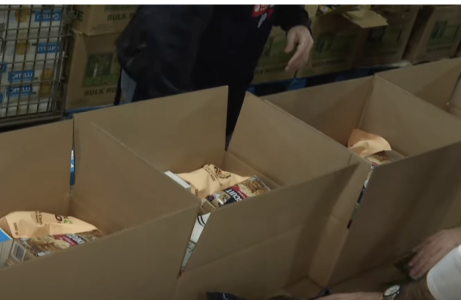Trump’s "MAHA food boxes" plan: What it could mean for seniors who rely on grocery aid
By
Veronica E.
- Replies 5
For many seniors living on a fixed income, monthly grocery programs are more than just a convenience—they’re a critical part of staying healthy and independent.
These programs help stretch tight budgets, ease the stress of rising food costs, and ensure that basic nutrition is never out of reach.
Now, a new proposal from the Trump administration is gaining attention for its potential to change that system.
The plan introduces what are being called “MAHA food boxes,” which could replace the current method of food delivery for low-income seniors with a new model focused on pre-packaged boxes sourced directly from farmers.
Although still in the proposal stage, the idea is already generating discussion among healthcare providers, food advocates, and community organizations.
At the heart of the conversation is a fundamental question: how can we continue to support older Americans in a way that respects their needs, protects their health, and preserves their ability to make personal choices about the food they eat?

The term “MAHA” stands for “Make America Healthy Again,” a slogan promoted by Health and Human Services Secretary Robert F. Kennedy Jr.
According to the proposal, MAHA boxes would contain items grown by American farmers and be delivered directly to eligible households.
According to the Trump budget proposal, the MAHA food boxes aim to improve nutrition by replacing the current model, which it claims relies too much on processed items: “Unlike the current approach using food banks, which provide those in need with shelf-stable foods that are high in sodium and other harmful ingredients, MAHA boxes would be filled with commodities sourced from domestic farmers and given directly to American households.”
The plan would specifically replace the Commodity Supplemental Food Program (CSFP)—a long-running federal program that helps around 730,000 low-income seniors supplement their diets each year.
In 2024, the CSFP operated on a $389 million budget.
That’s a fraction of what the Supplemental Nutrition Assistance Program (SNAP), or food stamps, spends—roughly $100 billion per year to serve 41 million Americans.
Instead of picking up boxes through local food banks or receiving deliveries from community organizations, seniors would receive these new MAHA food boxes with contents chosen by the government.
Through CSFP, eligible seniors currently receive monthly food boxes that include canned vegetables, pasta, cereal, and lean proteins.
These items are shelf-stable, making them easier to store and prepare—especially for those who have limited mobility, don’t drive, or live alone.
Many community programs go the extra mile by delivering the food directly to seniors’ doors.
For example, the Share Food Program in Philadelphia provides 32-pound food boxes to more than 7,000 seniors each month, thanks to $4.5 million in CSFP funding.
Supporters say the MAHA boxes would be healthier and fresher, while also removing administrative costs by cutting out “middlemen” in the distribution process.
The USDA compared the proposal to the Farmers to Families Food Box program, which ran during the pandemic and delivered boxes of produce and meats through contracted suppliers.
"MAHA boxes would be more wholesome foods, and similar to the Farmers to Families Food Box, fresh foods..."
But food advocates say the logistics of getting fresh food from farms to seniors' homes—especially in rural or hard-to-reach areas—are far more complicated than the proposal suggests.
“We have no details about the logistics of the MAHA food boxes,” said George Matysik, executive director of the Share Food Program.
“This has been a continued challenge that we’ve had with this administration, where decisions are sort of made overnight.”
He also pushed back on claims that current CSFP boxes are unhealthy.
“What we do know is that the program that we currently have is working, and seniors have come to rely on us,” he said.
“For seniors, a lot of times it can be hard to make it out to the grocery store—it can be hard to get those core items that folks need. What we do at Share Food Program is take it directly to the doorstep of about 4,500 seniors.”
Aside from logistics, advocates also worry that standardizing the food boxes may leave out seniors’ dietary needs, cultural preferences, or health restrictions.
A one-size-fits-all approach could make it harder for some people to eat safely or enjoy meals that are familiar and comforting.
There’s also concern about dignity and independence.
Other proposals from the Trump administration have included restricting the use of SNAP benefits for items like soda and candy.
Some advocates have raised concerns that such limitations could affect personal choice and be viewed as stigmatizing.
The MAHA food box plan is still just a proposal—it would need approval from Congress to move forward.
But it fits into a larger effort by the Trump administration to reduce spending on safety net programs like SNAP, Medicare, and Medicaid.
In the meantime, advocates are urging lawmakers to slow down and listen to those who depend on the CSFP.
“Our seniors in particular are already hurting,” Matysik said.
As the MAHA food box proposal continues to spark discussion, one thing remains clear: any changes to food assistance programs should prioritize the well-being, dignity, and real-life needs of the seniors who depend on them.
Listening to their voices—and the organizations that serve them—will be essential in shaping solutions that truly support healthy, independent living.
Read next: The number one killer: What you need to know about America's deadliest health threat

Have you or a loved one received food boxes through a government program like CSFP? Would you prefer a fresh-food delivery, or do you rely on shelf-stable items for convenience and safety? Do you feel that food assistance should come with restrictions—or should people be trusted to choose what’s right for them? Let us know your thoughts in the comments!
These programs help stretch tight budgets, ease the stress of rising food costs, and ensure that basic nutrition is never out of reach.
Now, a new proposal from the Trump administration is gaining attention for its potential to change that system.
The plan introduces what are being called “MAHA food boxes,” which could replace the current method of food delivery for low-income seniors with a new model focused on pre-packaged boxes sourced directly from farmers.
Although still in the proposal stage, the idea is already generating discussion among healthcare providers, food advocates, and community organizations.
At the heart of the conversation is a fundamental question: how can we continue to support older Americans in a way that respects their needs, protects their health, and preserves their ability to make personal choices about the food they eat?

Proposed MAHA food boxes could replace current grocery aid programs for senior. Image Source: YouTube / CityNews.
What are MAHA food boxes?
The term “MAHA” stands for “Make America Healthy Again,” a slogan promoted by Health and Human Services Secretary Robert F. Kennedy Jr.
According to the proposal, MAHA boxes would contain items grown by American farmers and be delivered directly to eligible households.
According to the Trump budget proposal, the MAHA food boxes aim to improve nutrition by replacing the current model, which it claims relies too much on processed items: “Unlike the current approach using food banks, which provide those in need with shelf-stable foods that are high in sodium and other harmful ingredients, MAHA boxes would be filled with commodities sourced from domestic farmers and given directly to American households.”
The plan would specifically replace the Commodity Supplemental Food Program (CSFP)—a long-running federal program that helps around 730,000 low-income seniors supplement their diets each year.
In 2024, the CSFP operated on a $389 million budget.
That’s a fraction of what the Supplemental Nutrition Assistance Program (SNAP), or food stamps, spends—roughly $100 billion per year to serve 41 million Americans.
Instead of picking up boxes through local food banks or receiving deliveries from community organizations, seniors would receive these new MAHA food boxes with contents chosen by the government.
Also read: Popular foods could look very different soon—RFK Jr’s FDA cracks down on this ingredient
How the current system works
Through CSFP, eligible seniors currently receive monthly food boxes that include canned vegetables, pasta, cereal, and lean proteins.
These items are shelf-stable, making them easier to store and prepare—especially for those who have limited mobility, don’t drive, or live alone.
Many community programs go the extra mile by delivering the food directly to seniors’ doors.
For example, the Share Food Program in Philadelphia provides 32-pound food boxes to more than 7,000 seniors each month, thanks to $4.5 million in CSFP funding.
Also read: This could change what you eat—State targets 9 cancer-causing ingredients
Mixed reactions to the proposed changes
Supporters say the MAHA boxes would be healthier and fresher, while also removing administrative costs by cutting out “middlemen” in the distribution process.
The USDA compared the proposal to the Farmers to Families Food Box program, which ran during the pandemic and delivered boxes of produce and meats through contracted suppliers.
"MAHA boxes would be more wholesome foods, and similar to the Farmers to Families Food Box, fresh foods..."
But food advocates say the logistics of getting fresh food from farms to seniors' homes—especially in rural or hard-to-reach areas—are far more complicated than the proposal suggests.
“We have no details about the logistics of the MAHA food boxes,” said George Matysik, executive director of the Share Food Program.
“This has been a continued challenge that we’ve had with this administration, where decisions are sort of made overnight.”
He also pushed back on claims that current CSFP boxes are unhealthy.
“What we do know is that the program that we currently have is working, and seniors have come to rely on us,” he said.
“For seniors, a lot of times it can be hard to make it out to the grocery store—it can be hard to get those core items that folks need. What we do at Share Food Program is take it directly to the doorstep of about 4,500 seniors.”
Also read: What’s next for federal health programs? Proposed cuts raise questions
More than just food—why choice and dignity matter
Aside from logistics, advocates also worry that standardizing the food boxes may leave out seniors’ dietary needs, cultural preferences, or health restrictions.
A one-size-fits-all approach could make it harder for some people to eat safely or enjoy meals that are familiar and comforting.
There’s also concern about dignity and independence.
Other proposals from the Trump administration have included restricting the use of SNAP benefits for items like soda and candy.
Some advocates have raised concerns that such limitations could affect personal choice and be viewed as stigmatizing.
What happens next?
The MAHA food box plan is still just a proposal—it would need approval from Congress to move forward.
But it fits into a larger effort by the Trump administration to reduce spending on safety net programs like SNAP, Medicare, and Medicaid.
In the meantime, advocates are urging lawmakers to slow down and listen to those who depend on the CSFP.
“Our seniors in particular are already hurting,” Matysik said.
As the MAHA food box proposal continues to spark discussion, one thing remains clear: any changes to food assistance programs should prioritize the well-being, dignity, and real-life needs of the seniors who depend on them.
Listening to their voices—and the organizations that serve them—will be essential in shaping solutions that truly support healthy, independent living.
Read next: The number one killer: What you need to know about America's deadliest health threat
Key Takeaways
- President Trump’s proposed budget could see major changes to the Commodity Supplemental Food Program (CSFP), which currently provides food aid to around 730,000 low-income senior citizens in the US.
- The new plan suggests replacing CSFP with "MAHA food boxes," containing products sourced directly from American farmers, as part of a push to "Make America Healthy Again."
- Critics and advocates for seniors raise concerns about the logistics of distributing MAHA food boxes and whether they would meet the needs of older Americans who often require shelf-stable food and home delivery.
- There is uncertainty about the future of food assistance for seniors, as the plan is part of a broader trend of funding cuts to food and welfare programs, raising fears for the wellbeing of vulnerable members of the community.
Have you or a loved one received food boxes through a government program like CSFP? Would you prefer a fresh-food delivery, or do you rely on shelf-stable items for convenience and safety? Do you feel that food assistance should come with restrictions—or should people be trusted to choose what’s right for them? Let us know your thoughts in the comments!






